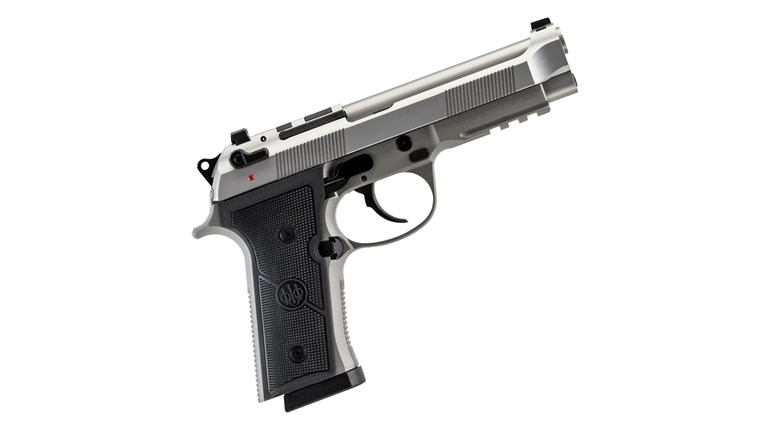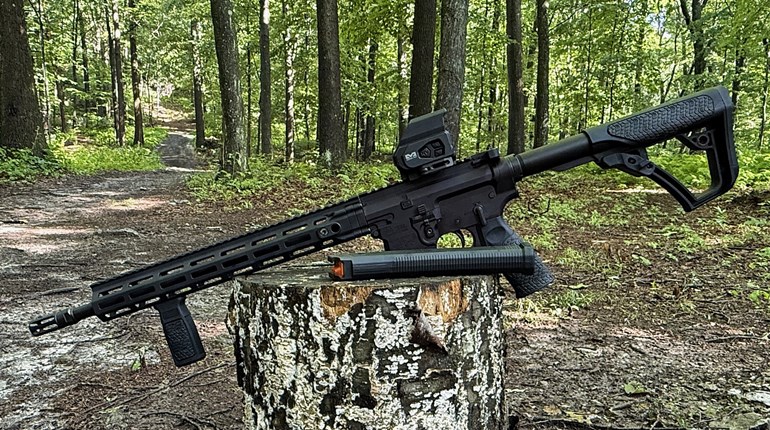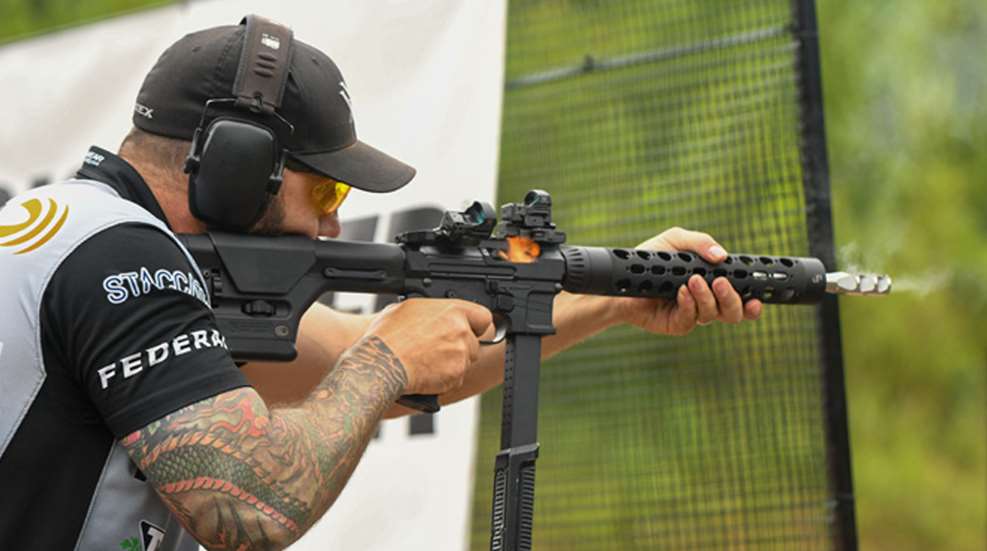
In 2018, I was the Match Director for the Area 5 PCC Championship held at Silver Creek Conservation Club. That year the Area 5 Championship was being held on a range that didn’t allow centerfire rifle in several of its shorter pistol bays, so it was decided to hold a separate match just for PCC. During the match, I kept thinking to myself how fun it would be to have a PCC and handgun match combined. Again, in 2019 I was part of the Midwest PCC Match at Silver Creek, designing stages for it and assisting Kevin Mayfield who had stepped up as Match Director. The 2-Gun style of match was again on my mind, and after the 2019 match, I took out my notepad and sketched out a PCC and handgun match.
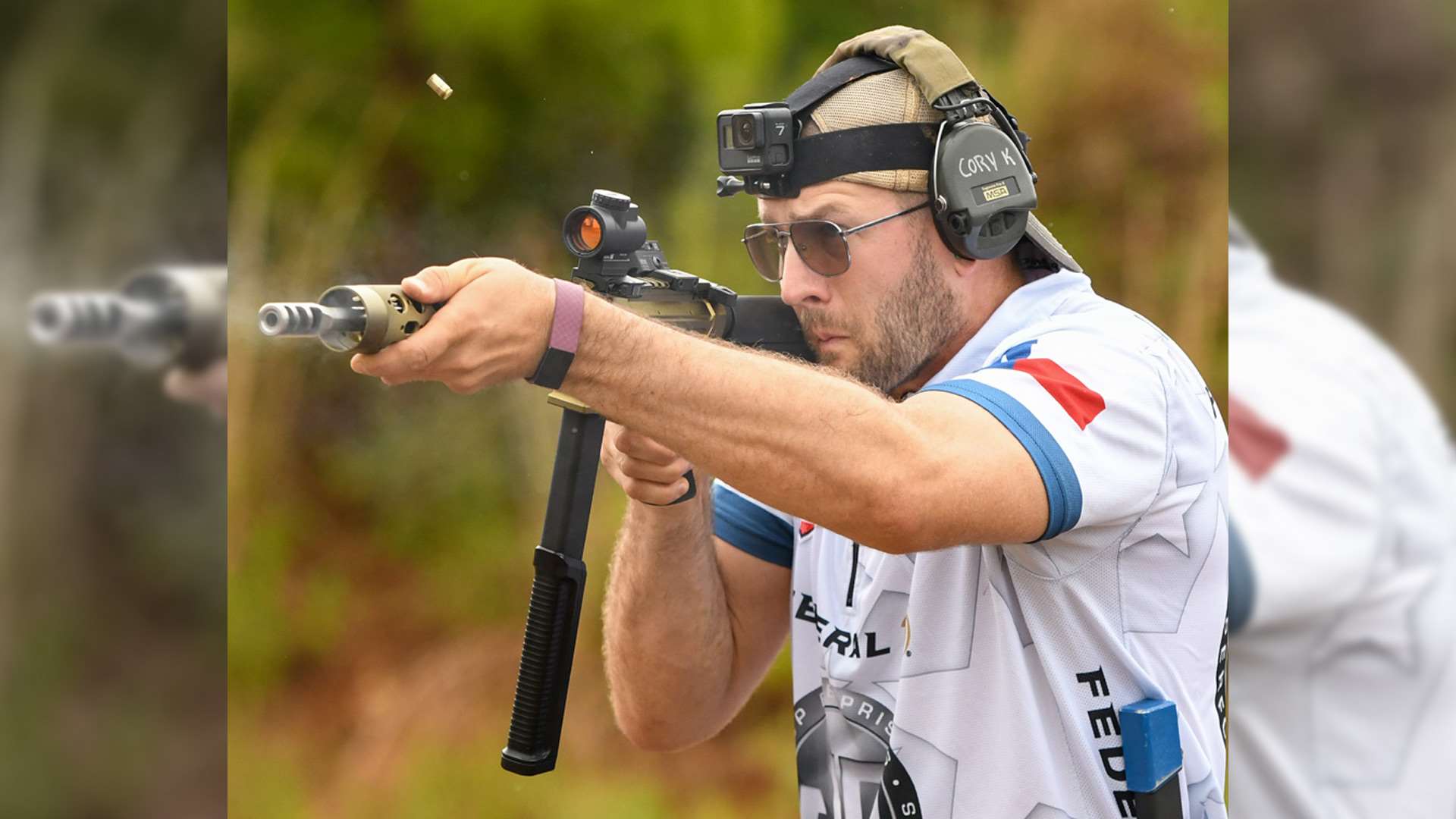
Fast forward to 2020, when USPSA learned that Shannon Smith would be departing Universal Shooting Academy. It left us with the need for a range and Match Director for our 2021 Multi-Gun Nationals match that had previously been held at the Florida range. Time was short, as we already had the 2021 calendar set with the other events. I dug out the notebook, presented my persuasive arguments, and the 2-Gun PCC/Handgun Nationals was scheduled for June at the CMP Marksmanship Park in Talladega, Ala. A quick call to our partners at SIG Sauer, and we had a title sponsor who also thought this was a great idea for a match.
Why PCC and not center-fire rifle? There were a couple of reasons. One was distance. While the Action Shooting bays at Talladega are large, the longest distance that could be achieved was under 100 yards. This is not a difficult shot for a center-fire rifle. The other reason is that we were also trying to show that different match formats can be run under the current Multi-Gun rules. It doesn’t have to be rifle, pistol or shotgun for each match. You can run single division matches like shotgun or rifle only under the Multi-gun ruleset. Finally, for USPSA, PCC and handguns are popular. Combining the two in one match, under the Multi-Gun rules, was to attract competitors who enjoy both, but may not play in the Multi-Gun world.
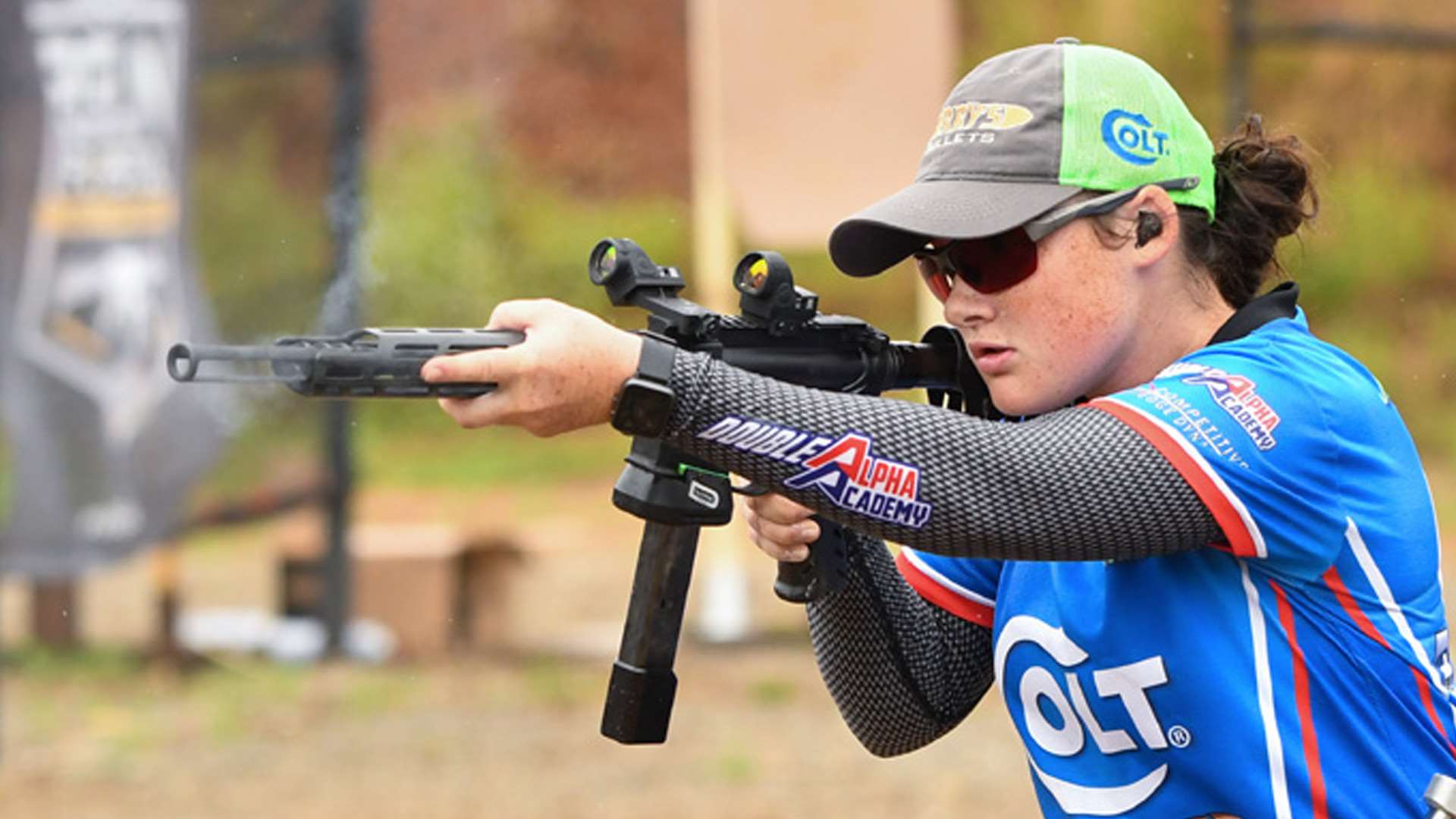
How does the 2-Gun format work in USPSA Multi-Gun? On the surface, it seems rather simple in that you have specific targets for each type of firearm. In this case, IPSC targets are dedicated for PCC and USPSA targets are for handgun. Steel targets are optional for either type of firearm and frangible (clay birds) are PCC-only targets. The scoring has to be Time Plus under the mutli-gun rules. Time Plus is your time to shoot the stage plus any additional penalties. Penalties range from not neutralizing a target, meaning you didn’t have at least one alpha or two hits anywhere. Example would be a PCC target with only one scored Charlie hit would result in your time to shoot the stage plus 5 seconds for the Failure to Neutralize penalty. Other penalties are Failure to Engage, which is incurred for misses and non-engagement of target, and No-Shoot penalties also add time. Each stage is worth 100 points and the fastest time wins the stage points, followed with the next shooters receiving their percentage of points. Being fast is important, but misses and other procedural penalties add time quickly.
The divisions for this match were based on the handgun. You either shot Open or Limited, depending on how your handgun was set up. If you were running an optic, then your handgun would place you in Open division. If you were running iron sights, and your handgun met the rest of the division equipment rules, then it would be Limited—meaning no comp, 140 mm magazines, etc. As for the PCC, anything pretty much goes with regard to how many optics or type of optic, and magazine size. The number-one question we got was Major or Minor? Under Time Plus scoring, there is no major or minor scoring, but steel must fall to score.
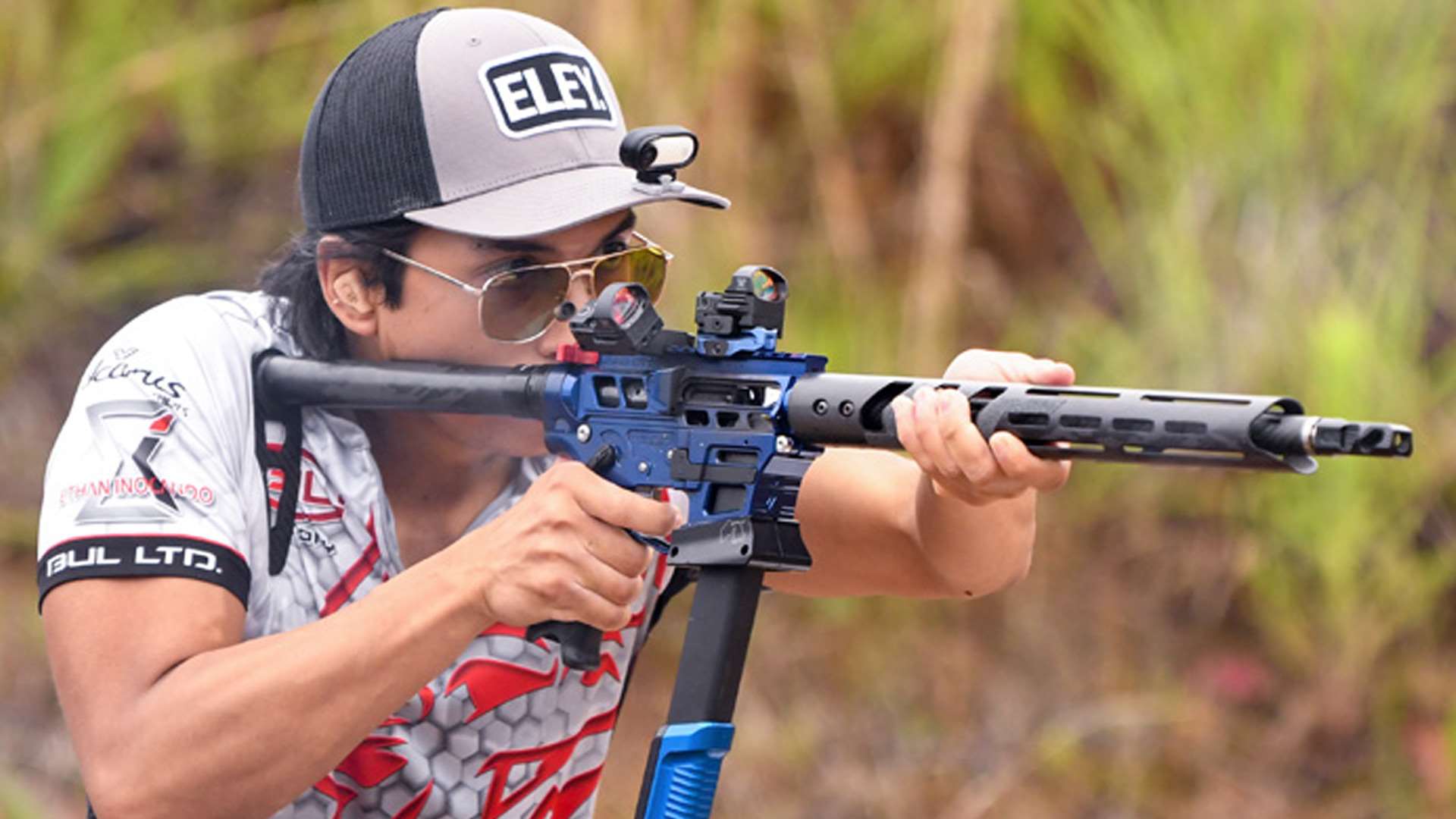
The match was set up to run over two days, with 11 stages laid out in 10 bays, divided up into two zones. Competitors would shoot the stages in one zone each day and then flip to the other zone for the second day. The stages for each zone were designed to test who was proficient with both the handgun and the PCC. I purposely designed them to try to balance the round count and target presentation between both firearms. If you count on each competitor most likely shooting two rounds on each cardboard target, the match was going to be about 250 pistol and 250 PCC rounds to complete. There were two handgun-only and two PCC-only stages mixed into the match.
The June 4–6 date was selected for the event because it was far enough out from other majors including the Back to Back Nationals that are coming up in October. We also hoped to dodge any weather, but unfortunately that was not the case. The match was hit with rain and lightning, which caused the added difficulty of shooting with bagged targets and delays that made the match run longer than intended.
Zone 1 had six stages in the five bays that were used, starting with a handgun-only stage called “Legion.” Stage 1 was a side-to-side stage with a wide shooting area and a start position in the middle. There were 15 USPSA targets and six poppers. The minimum round count was 21. Since in Time Plus scoring a single Alpha hit on a scoring target neutralizes it, the round counts are presented as minimum—but let’s be real, this was going to be at least 36 rounds. There was hardcover on all the targets, and the shooting positions with vision barriers made this one difficult to shoot. Shannon Smith edged out Nicholas Realuyo with a 22.34-second run in Open division shooting his SIG 320 Carry Optics set-up. Penalties stacked up on this stage, even for the competitors running red dots. Brian Nelson blazed through this stage in Limited division with a 21.76 raw time, plus his five-second penalty for a total of 26.76, ahead of Tim Yackley’s clean run of 28.48 seconds.
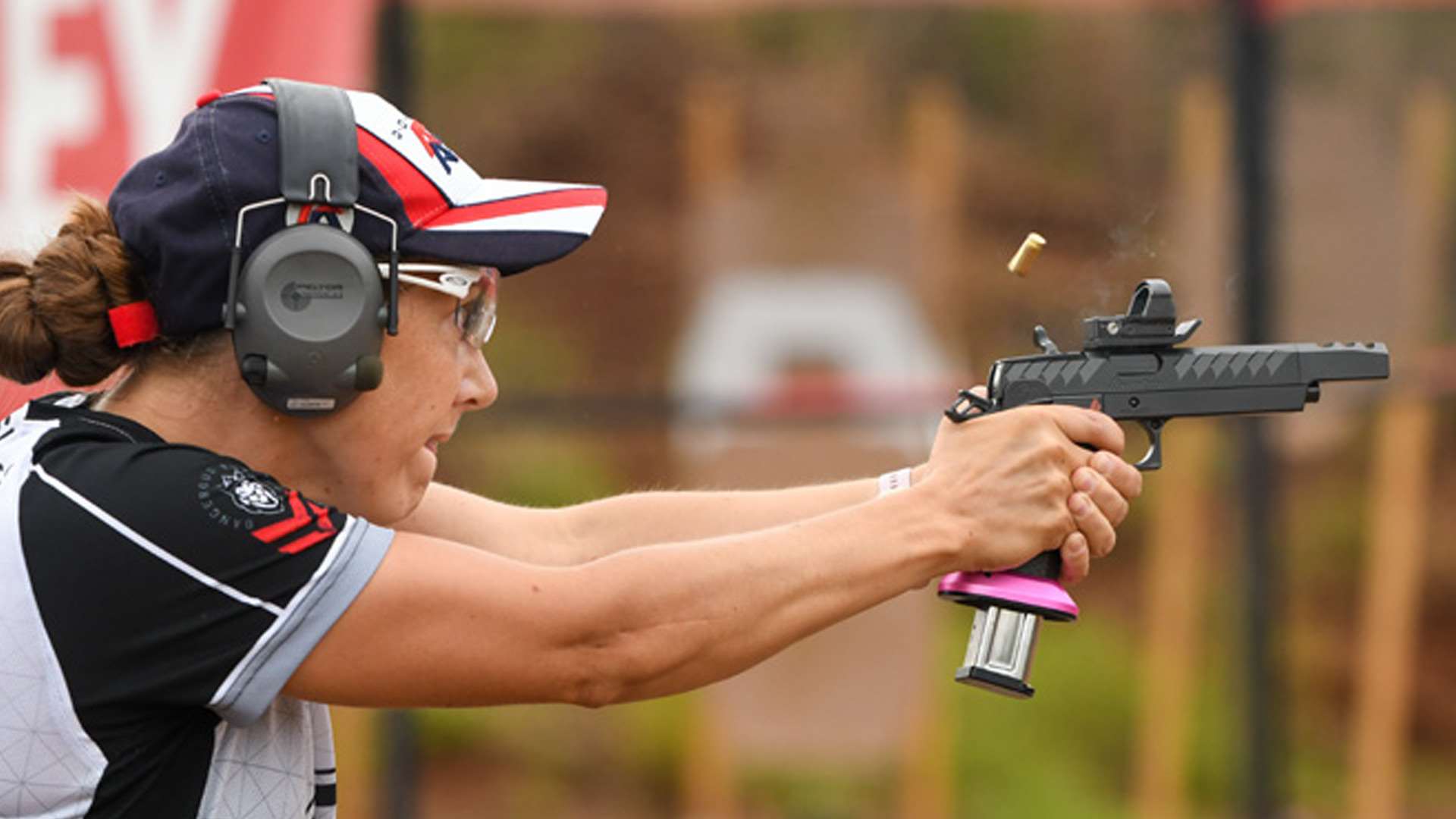
Stage 2 “Tango” was designed by Jodi Humann and was by far one of the toughest stages of the match. Both handgun and PCC were required to take on this stage with 12 USPSA pistol targets, IPSC PCC targets and four poppers that were optional for either firearm. This stage started the competitors with either their loaded handgun or PCC, with the other firearm being staged in the drop box. This gave the competitors the option of what firearm they were going to start with, which would decide on how they took the stage on.
In multi-gun, a competitor can retrieve a handgun and holster it while shooting the other firearm. On this stage, there was an advantage to starting with your handgun and working through the targets on the left side, then holstering your handgun and retrieving the PCC. Once you had the PCC you would work back down the left side, dropping down for the targets through the center low port and working back up the right side. Once you finished up the PCC targets you could abandon your PCC in the drop box, grab your holstered pistol and finish out the stage. There was a lot going on with this stage as the USPSA and IPSC targets were mixed in together for competitors and the Range Officers to ensure they engaged all the targets, but also with the right firearm. John McClain took a stage win here in Limited, shooting it clean with no penalties in 38.35 seconds. There were some faster times, but the penalties in Time Plus scoring add up quickly. Todd Jarrett ran the plan mentioned in 31.09 seconds for his first stage win of the match in Open division.
Stage 3 “226” was the first stage of the match that was going to stretch out some shots for the competitors. All competitors started with a loaded and holstered handgun at the rear of the shooting area, and the PCC at the far down range drop box. There were steel plates at 50 yards, as well as clay birds spread out from 15 to 35 yards. A small clay bird at 35 yards with a red dot on your PCC is a tough shot. Poppers were mixed in, with one activating a swinger that was a PCC-only target. The plan was to work your way down range engaging the USPSA pistol targets that were staggered, transitioning side to side. Next, dump the handgun and start working on the PCC targets, working back up range, where you had to go to either far right or left sides to engage the 50-yard plates that also had some IPSC targets at 40 yards on the right side. Brian Nelson and John McClain were fighting it out on this one, with Nelson taking the Limited division stage 50.40 over McClain’s 51.62-second run. Josh Froelich had no trouble here in Open, with a 44.20-second run ahead of Scott Greene’s 50.33-second time.
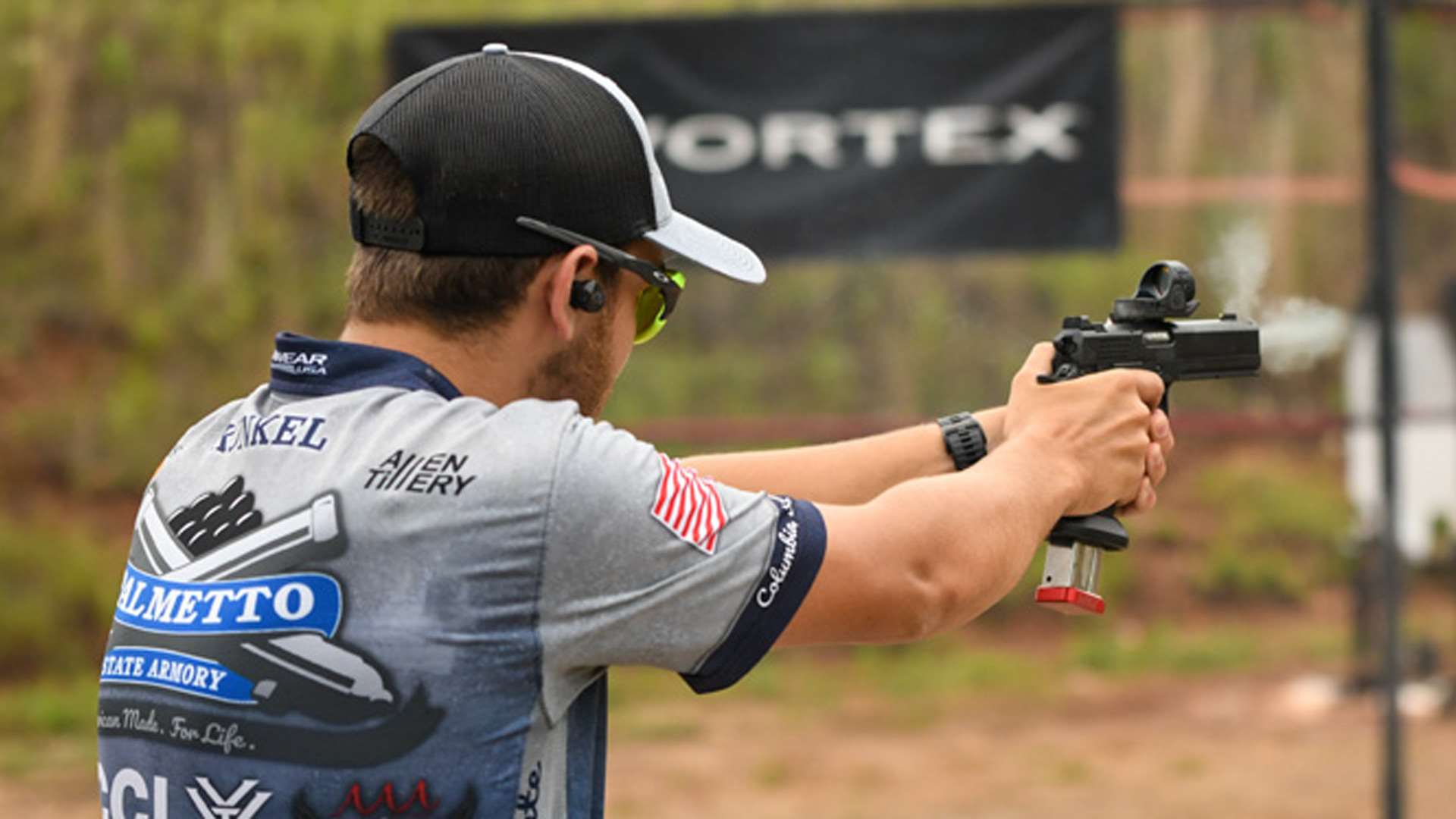
Making use of the wide bays, Stage 4 “Scorpion” would push competitors with both firearms as they worked through the mix of steel plates, clay birds and cardboard targets that required at least 39 rounds—but really, it was more like 63 rounds—if you went one for one on the clay birds. Either starting with PCC or pistol on the rear center fault line with the other gun in the drop box in the center of the shooting areas, competitors were going to have to hit the far back left and right corners with their PCC. The natural choice was to go PCC first, working forward to take the IPSC targets, clays and what steel plates you could with the “long gun” before swapping to pistol. With your PCC abandoned and working with your handgun, you had to hit targets on the right side, move into a forward position taking USPSA cardboard through a tight port, before moving forward to left to finish out the remaining targets and picking up the optional steel plates if you didn’t get them with your PCC. Walther’s Hwansik Kim, who has taken a liking to long guns, took the Open division stage win over Todd Jarrett with a 0.10-second faster time, 44.73 versus 44.83. Brian Nelson had the time to beat here in Limited with a 45.25-second run, but had a five-second failure to neutralize procedural, giving the stage to McClain as they continued to battle it out.
Finishing out this zone, the next bay had two stages in it, one for PCC only and the other pistol only. Stage 5 “MPX” had an unloaded PCC lying on a table, with 10 poppers and 10 IPSC cardboard targets. Two of the targets were swingers, activated by separate poppers. I like having down and dirty speed shoots like this where everything has to go just right starting with the load after the buzzer. The steel was staggered on either side of the center where the two swingers were going to be activated, so timing had to be right with how you went about engaging the poppers. J.R. Guerra ran this in 13.58 seconds without penalties for a Limited stage win. Max Leograndis came to life on this stage with a 12.46-second run for his first stage win in Open.
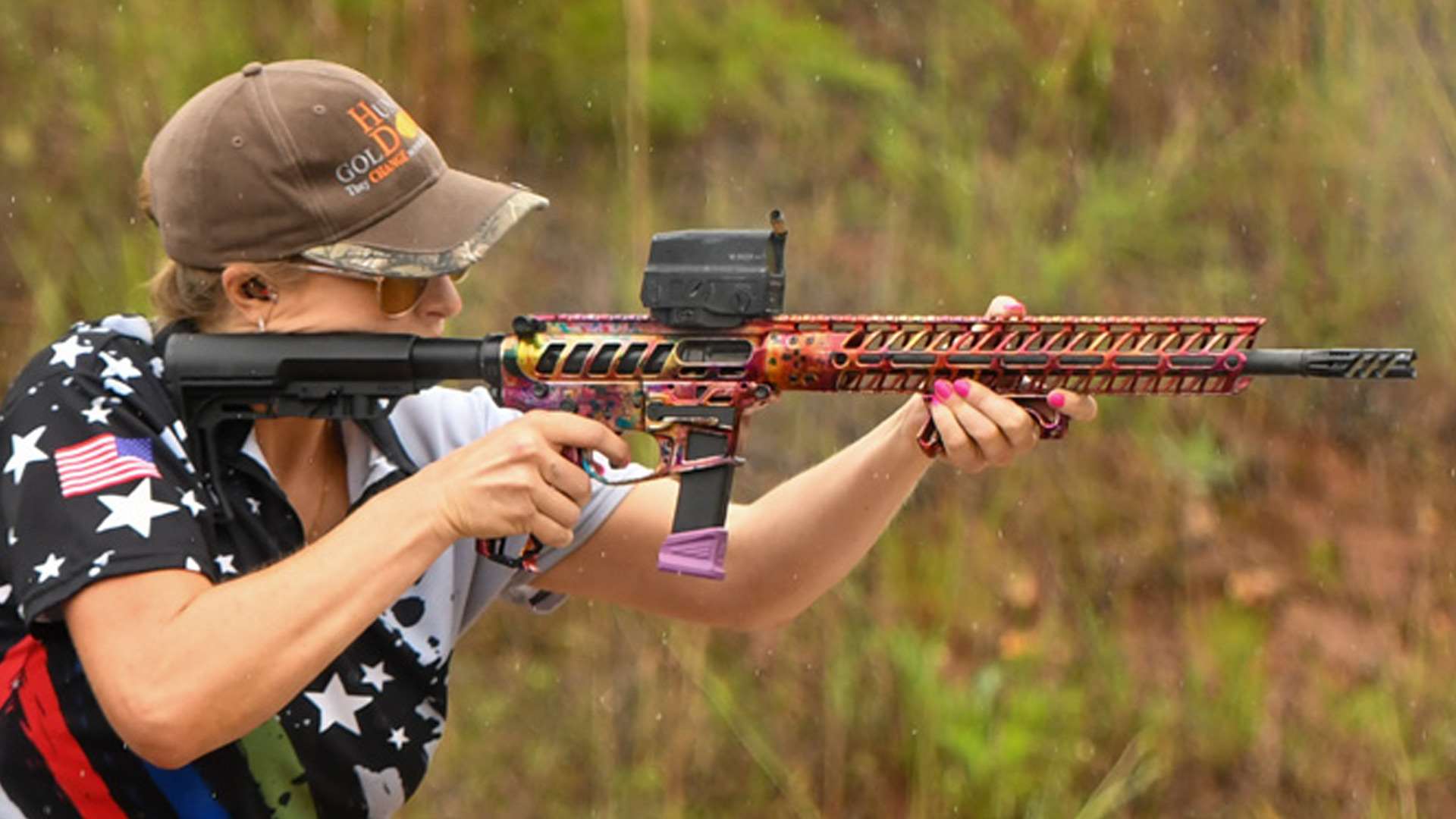
Stage 6 “M17” was all pistol with its 10 USPSA cardboard targets and six poppers. A loaded and holstered start on either end of the shooting area would force competitors to go side to side with three target arrays positioned on either outside array and the poppers with two sets of double stacks in the center section. The double stacks were only available from the far outside positions, and the poppers would have to be taken going across the middle. This is the the type of stage that can suck people into overestimating the difficulty of it, missing a position or, with the added hardcover and no-shoots, not giving the targets the respect they need. Michael Hwang picked up a stage win in Open in 12.64 seconds, just slightly ahead of Ian McPherson in Open, with Brian Nelson taking another stage win in Limited.
With the first six stages done, the competitors were going to face the five bays that are actually the larger ones at the range. Stage 7 “X-Ray” was designed to cause competitors to have to go from the shooting areas on either side, no matter what firearm they started with. With two shooting boxes and dump bins adjacent to them, competitors could start in either box with either firearm and the other one would have to be in the opposite box. There were nine USPSA and nine IPSC targets with eight poppers and six static steel plates. The steel was optional for either firearm, but the targets were going to force competitors to go back and forth depending on which firearm they started with, since there were both types of targets only available from either side. Limited division saw Brian Nelson continue to dominate the match with another stage win, shooting this one in 31.06 seconds. Grant Kunkel set down his rimfires and was giving chase at this match, just barely falling behind Max Leograndis’ run of 28.54, compared to Kunkel’s 29.59 in Open.
Stage 8 "Copperhead" was all PCC targets with a mix of eight clay birds, five static steel plates, six poppers and six IPSC targets, three of which were activated moving targets. With a start down range on the forward fault line, there was a port to left for some of the plates and clay birds, but some of them could be taken from the front opening at the start where the poppers were stacked up. Timing was going to be important with three activated targets. The far left side had the other three IPSC targets, with the inner right one at a hard lean position to get. The three activated targets were on the far right of the stage available from the back right corner. The reigning PCC Champion ran this stage in 19.29 seconds, giving Max Leograndis another stage win over Zack Smith’s 19.65-second run. Ian Meyers in Limited grabbed a stage win with a 20.56-second run.
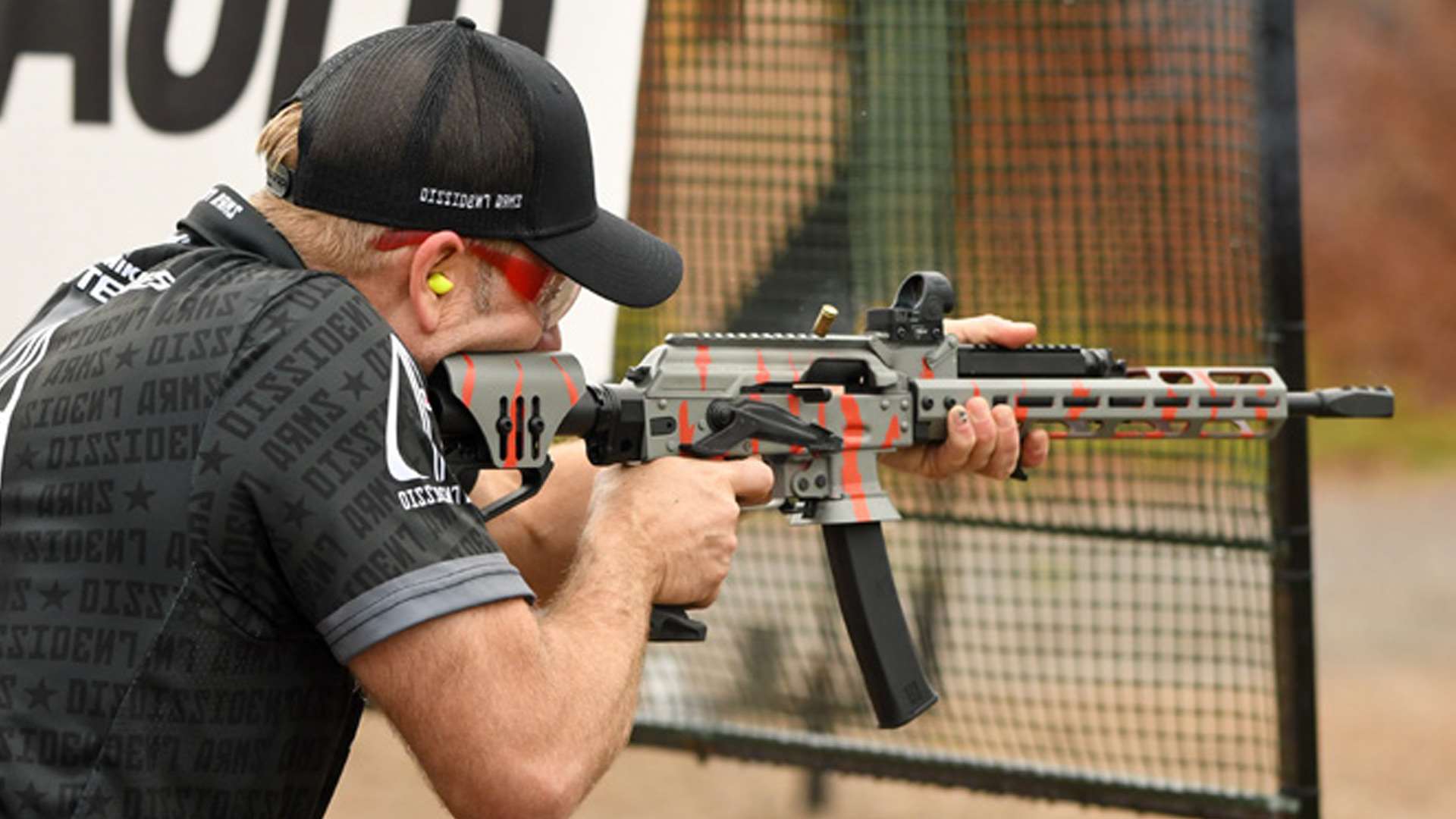
The three remaining stages of the match were on the three biggest bays at the park, and they were going to test the competitors with stage planning and execution. Each stage allowed the competitors to choose which firearm they wanted to start with, requiring the other to be positioned in the drop box. Each of the stages were going to test some longer shots, many options of stage planning—and the ability to get tripped up and push too hard, adding time plus penalties.
“V-Crown” Stage 9 was going to push competitors to zigzag back and forth from each side and corner twice to ensure they got all the right targets with the right firearm. With five static steel plates, nine USPSA and nine IPSC targets and two poppers (one activating a swinger with a pistol-only target), competitors were going to have to really focus on execution. It would be easy to engage the wrong target with the wrong firearm, so ROs were also going to have to be diligent in what was being engaged from where and with what firearm. John McClain edged out Cody Leeper for another stage win, as did Leograndis in Open division with a 22.96-second time.
Stage 10 “Whiskey” occupied the widest bay at the range. Eleven USPSA and 11 IPSC targets, five clay birds, four static steel plates and four poppers were spread across this large bay, with a drop box in the center front fault line downrange. There is a USPSA Mult-Gun rules that allows for competitors to set a firearm down that isn’t considered abandoned—and that you can holster a loaded pistol while shooting the other firearm. There was a spot on this stage where some competitors decided to set their PCC down, draw the handgun and engage targets, then holster and retrieve the PCC to finish off some targets, eliminating to need to move forward and drop the handgun in the drop box. It was a risk versus reward maneuver and, if executed correctly, saved time. With a 45.57-second run, Andre Desautel won the stage in Limited, and Leograndis grabbed another one in a row here, leading into the last stage.
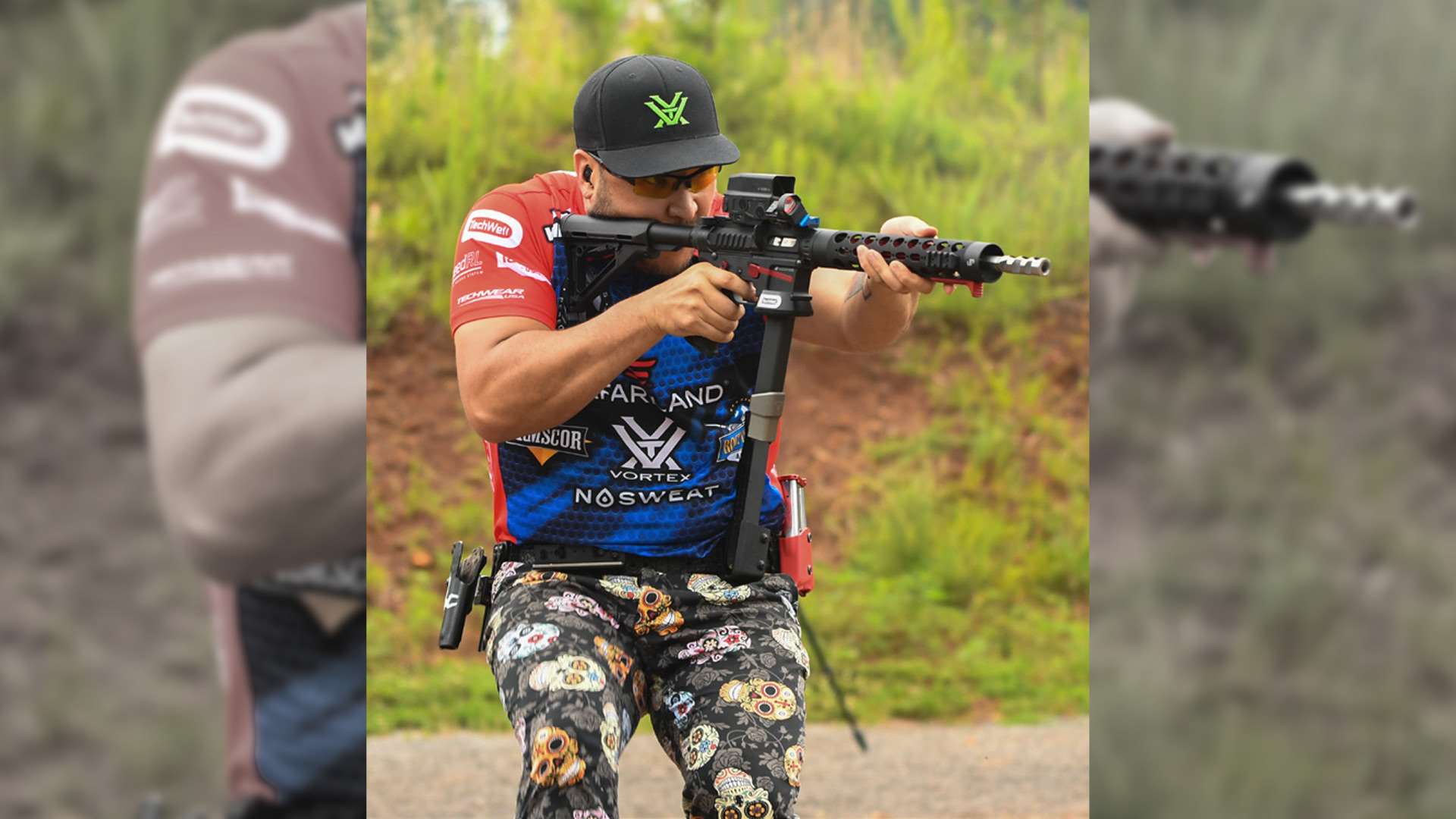
The longest bay was home to Stage 11 “320.” Five static steel plates out to 65 yards, three poppers with two activating movers and 10 USPSA and 10 IPSC targets were set up to finish out the first 2-Gun Nationals. Competitors would have to work forward and backward after transitioning to the other firearm, taking targets on either side of the shooting area as well as the long shots on the plates. Desautel finished his match here with a win in Limited, running the stage in 42.25 seconds. Leograndis ran it in 36.89 to claim the USPSA 2-Gun Open National Championship title.
This match was more technical than I had anticipated, and the stage challenges—not just the shooting, but planning your run—also took much longer than planned. We have had several after-action reports on the match. There were several hurdles to overcome for a match that we green-lighted in December 2020 and had on the ground running in June 2021. We would never have been able to pull it off if it had not been for the amazing staff that came together and fought through the weather, the difficulties of running these stages and the time crunch they were under. By the time you read this, we hope to have the 2022 schedule ready for release. In that time we hopefully will have figured out where we are heading with this format. Everyone I talked to liked the match, but no one has ever said that we who are competitive shooters are the leaders of our Mensa Chapters, either.
A huge thanks goes the folks at the CMP Marksmanship Park, especially Joey Hardy and Rob Creswell. The group of volunteer staff that continued to push through and get the job done when called can never be thanked enough. Thanks also go to Shannon Smith for jumping on to assist as co-match director, to Troy McManus and Jodi Humann for being the range masters, and to J.B. Creech and Steve Wright for knocking out stats. Thank you to all the competitors who signed up and came out to test my idea that a pistol and PCC match could be fun.
Article from the September/October 2021 issue of USPSA’s magazine. All photos by Jake Martens.
Read more: Kenshiro Nagata: Youngest World Speed Shooting Champion Ever













